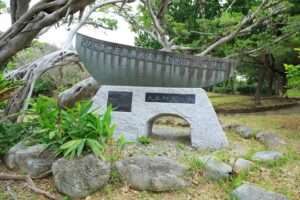The families from Min, known as the 36 families from Min (閩人三十六姓), were sent to the Ryukyu Islands (modern-day Okinawa) under the orders of the Ming Chinese Emperor. These families hailed from the Min region of Fujian Province in southern China.
During the Ming Dynasty (1368-1644), the Ming Emperor recognized the strategic importance of maintaining strong relations with the Ryukyu Kingdom, an independent kingdom situated between China and Japan. To strengthen diplomatic ties and cultural exchange, the Ming Emperor decided to dispatch Chinese bureaucrats, craftsmen, and other skilled individuals to assist and support the Ryukyuan government.
Specifically, the 36 families from Min were selected and sent from the Min region of Fujian Province in China to the Ryukyu Islands. These families brought with them their expertise, knowledge, and cultural practices from their homeland. They played crucial roles in the Ryukyuan administration, serving as government officials and diplomats in fostering relations with China, Japan, and other neighboring countries.
The families from Min settled in Kume-mura (Kuninda in the Okinawan language), a community in Naha, the capital city of Okinawa. Kume-mura became the residential area for the families and served as an intellectual and cultural hub. The families maintained their cultural identity and traditions while integrating with the local Okinawan community.
Martial Arts Transmission.
The Min families are believed to have potentially influenced Okinawan martial arts, although there is currently no historical evidence to support this claim. However, it is generally acknowledged that they introduced some form of martial art. It is widely accepted that their martial arts practices merged with the local Okinawan self-defense techniques. This fusion of Chinese martial arts and Okinawan self-defense likely laid the foundation for the development of Todi (Toudi, Tode), which is considered a precursor to modern-day Karate.
Honoring the 36 Clans; Memorial Stones in Okinawa.

One notable memorial stone, known as the “Monument to the 36 Families from Min” or “Min Sangyo no Hi,” holds particular significance in Naha, the capital city of Okinawa. Situated in Kume-mura, the historic settlement where the families from Min resided, this monument stands as a symbol of their importance. Inscriptions in both Chinese and Japanese languages on the stone acknowledge their role in the history of Okinawa and highlight the historical connections between the two cultures. The monument serves as a lasting testament to the families’ contributions and cultural heritage.
The Legacy of Kume-mura.
The settlement of the 36 families from Min in Kume-mura left an indelible mark on Okinawa’s history and culture. While the extent of their practice of Chuan-fa may not be fully known, their presence and cultural influence played a crucial role in shaping the martial arts landscape of Okinawa. The families from Min not only contributed to the cultural and intellectual development of Okinawa but also potentially laid the groundwork for the emergence of Karate as a distinct martial art form. Their legacy continues to be recognized and celebrated as an integral part of Okinawa’s rich cultural heritage.
Thanks for reading
Gert
